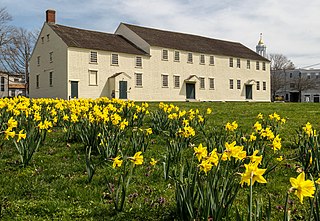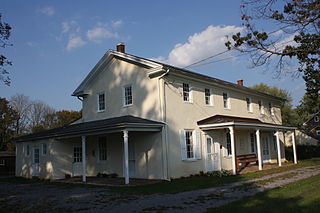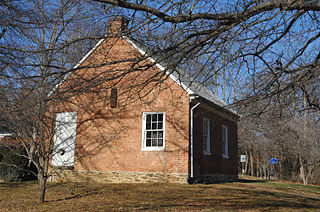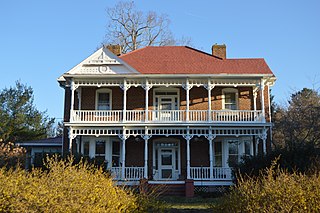Lincoln is a historic unincorporated village in the Loudoun Valley of Loudoun County, Virginia, located approximately 1.5 miles (2.4 km) south of Purcellville. It was established as the community of Goose Creek during the 1750s by Quaker settlers and renamed "Lincoln" for the president of the same name, shortly after his election in 1860.

A Friends meeting house is a meeting house of the Religious Society of Friends (Quakers), where meeting for worship is usually held.

Crosswicks is an unincorporated community and census-designated place (CDP) located along the Crosswicks Creek in the northern part of Chesterfield Township in Burlington County in the U.S. state of New Jersey. The area is served as United States Postal Service ZIP Code 08515.

The Flushing Friends Quaker Meeting House, also the Old Quaker Meeting House, is a historic Quaker house of worship located at 137-16 Northern Boulevard, in Flushing, Queens, New York. It was declared a National Historic Landmark in 1967 and a New York City designated landmark in 1970. Today, it still serves as a Quaker Meeting, with meetings for worship taking place every Sunday.

The Buckingham Friends Meeting House is a historic Quaker meeting house at 5684 Lower York Road in Buckingham Township, Bucks County, Pennsylvania. Built in 1768 in a "doubled" style, it is nationally significant as a model for many subsequent Friends Meeting Houses. It was declared a National Historic Landmark in 2003.

The Merion Friends Meeting House is an active and historic Quaker meeting house at 615 Montgomery Avenue in Merion Station, Pennsylvania. Completed about 1715, it is the second oldest Friends meeting house in the United States, with distinctively Welsh architectural features that distinguish it from later meeting houses. It is home to the Merion monthly meeting. The meeting house was declared a National Historic Landmark in 1999.

The Friends Meetinghouse and School is a Quaker meeting house and adjacent school building at the corner of Schermerhorn Street and Boerum Place in the Boerum Hill neighborhood of Brooklyn, New York City.

Makefield Meeting, also known as the Makefield Monthly Meeting; Meeting House at Dolington, is an historic, American Quaker meeting house complex that is located in Upper Makefield Township, Bucks County, Pennsylvania.

Birmingham Friends Meetinghouse is a historic Quaker meeting house at 1245 Birmingham Road in Birmingham Township, Chester County, Pennsylvania. The current meetinghouse was built in 1763. The building and the adjacent cemetery were near the center of fighting on the afternoon of September 11, 1777 at the Battle of Brandywine. Worship services are held weekly at 10am. The meetinghouse and adjacent octagonal schoolhouse were listed on the National Register of Historic Places as Birmingham Friends Meetinghouse and School on July 27, 1971.

The York Meetinghouse is an historic, American Quaker meeting house that is located at 135 West Philadelphia Street in York, York County, Pennsylvania.

Camden Friends Meetinghouse is a historic Quaker meeting house located on Delaware Route 10 in Camden, Kent County, Delaware. It was built in 1805, and was still in operation as a Quaker meeting house when it was listed on the National Register of Historic Places in 1973. A modern Camden Friends Meeting and Social Hall has been built behind the historic building, which now serves the meeting, and was designed to be energy-efficient and architecturally respectful of the historic building.

Appoquinimink Friends Meetinghouse, also known as the Odessa Friends Meetinghouse, is a very small but historic Quaker meetinghouse on Main Street in Odessa, Delaware. It was built in 1785 by David Wilson and added to the National Register of Historic Places in 1972. Members of the meeting, including John Hunn and his cousin John Alston, were active in the Underground Railroad and Harriet Tubman may have hid in the meetinghouse. Measuring about 20 feet (6.1 m) by 22 feet (6.7 m), it may be the smallest brick house of worship in the United States.

Hockessin Friends Meetinghouse is a historic Quaker meeting house and national historic district located at 1501 Old Wilmington Road in Hockessin, New Castle County, in the U.S. state of Delaware. The district encompasses three contributing buildings and one contributing site. It was added to the National Register of Historic Places in 1973.

Friends Meetinghouse is a historic Quaker meeting house at 4th and West Streets in Wilmington, Delaware in the Quaker Hill neighborhood. The meeting is still active with a membership of about 400 and is part of the Philadelphia Yearly Meeting. It was built in 1815–1817 and added to the National Register of Historic Places in 1976.

Rancocas is an unincorporated community located within Westampton Township in Burlington County, New Jersey. The name derives from the Native American word Rankokous. which was used in the name of the Powhatan Lenape Nation Indian Reservation located in Westampton Township. The name was also known as a sub-tribe of the Ancocus. The Reservation was a popular tourist destination for visitors from the Philadelphia area, New York, and local residents, before the Reservation became Rancocas State Park.

The Glebe of Shelburne Parish is a house built as a glebe in rural Loudoun County, Virginia around 1775 to attract a cleric to preach in the Shelburne Parish of the Anglican Church. Shelburne Parish, named for the Earls of Shelburne, desired in 1771 that a minister preach at Leesburg, Virginia every three months. The absence of a glebe and glebe lands detracted from efforts to recruit a parson, so in 1773 the parish purchased 473 acres (191 ha) and built a house on the property.

The Goose Creek Historic District is a rural landscape in the Goose Creek valley of Loudoun County, Virginia. The district covers about 10,000 acres (4,000 ha) south of Hamilton and Purcellville and includes the village of Lincoln. The majority of the district is farmland, with areas of forest along Hogback Mountain. The area was settled by Quakers in the mid-18th century, represented by simple houses and the Goose Creek Meetinghouse Complex in Lincoln, separately listed on the National Register of Historic Places. About 270 buildings lie within the district. The district includes 44 stone buildings, reflecting the popularity of this material in the 18th and 19th centuries in this area. Many houses have outbuildings and barns built in a manner complementary to the dwellings. By the mid-19th century, materials turned to brick, with the Glebe of Shelburne Parish an NRHP-listed example of a brick Federal style house, as well as the Israel Janney House.

Oakdale is a historic home and farm located near the town of Floyd in Floyd County, Virginia, United States. The house was built about 1890, and is a large two-story, three bay, frame dwelling in the Queen Anne style. It has a complex hipped roof and features a double-tier heavily ornamented front porch with turned posts, a spindle frieze, and sawn brackets. Also, on the property are a contributing large center-aisle barn, a two-story brick general store building, and a granary and garage.

The Roaring Creek Friends Meeting House is a historic place of worship for members of the Religious Society of Friends, or Quakers, in rural Columbia County, Pennsylvania, near Numidia on Quaker Meeting House Road.























